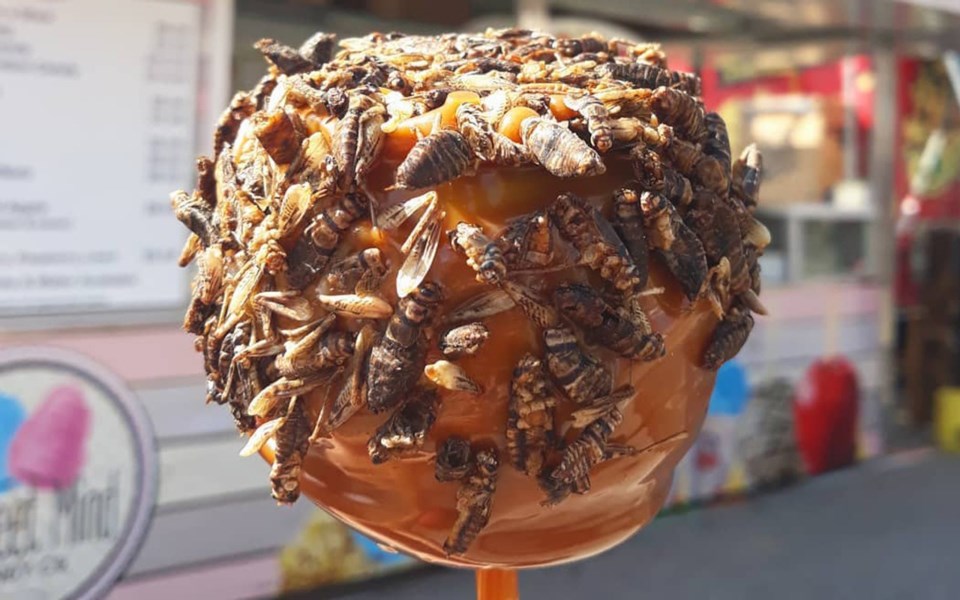Hey, it's PNE time! So grab your kids or your pals and your best sense of adventure and head on down to Vancouver's fairgrounds for the latest in thrills and chills—including one that's totally back to the future.
In the crowd-pleaser department, the top spots go to SuperDogs, now in its 40th year, and the fantastic wooden roller coaster—a classic celebrating 60. Right up there, too, is all the wild and wonderful fair food that riffs on equally timeless classics, albeit with a few new twists.
Just when you thought you couldn't resist, as you saunter down the midway with all the bright lights blaring and the rides whirring, you might find yourself with a sudden craving for Kit Kat fries—Kit Kat chocolate fingers battered and deep fried in a spin on the deep-fried Mars bars of yesteryear. Or the one-pound (!) meatball stuffed with mozzarella. Then there's ice cream like never before, from the trendy new coal-black charcoal soft serve filling a fresh pineapple, to classic '50s burgers topped with vanilla ice cream and garlic sauce.
But what I find totally exciting at this year's PNE is a new take on the age-old candy apple. This time it's dipped in gooey caramel and coated with (drum roll) nice, crunchy, roasted crickets—crickets straight from Entomo Farms in Ontario (entomofarms.com). ("Entomo" is from "entomophagy," meaning the human use of insects as food.)
Before going, euuugh, that's too much—even for fair food—consider this: about 80 per cent of the world's population eats insects, and they don't wait for the local fair to do so.
Every day, people eat insects in Thailand and China and Burma. They eat insects in Mexico. Termites are popular throughout Africa, and rice grasshoppers and yellow jacket wasp larvae are big in Japan. The list goes on. Beetles, caterpillars, bees, dragonflies, planthoppers, grasshoppers, locusts and, yes, those mighty crickets are all important, natural sources of nutrition.
Officially designated as part of the "mini-livestock" sector of food production, raising insects for us to eat emits fewer greenhouse gases and less ammonia than cattle or pig production, plus it uses much less land and water than the usual livestock production.
To top it off, eating insects isn't just some trendy fad or sideshow novelty. In fact, you could say that entomophagy is totally back to the future.
The Bible describes people eating insects. So do historical records from ancient Rome and Greece. And lately, the UN's Food and Agriculture Organization (FAO) has been intent on educating us about how smart eating insects is, now and into the future—especially we slaggarts in Europe and North America, pretty much the only places on Earth where entomophagy isn't cool.
The FAO, which partnered with Wageningen University in the Netherlands in 2014 to organize a world entomophagy conference there, has registered approximately 1,900 edible insect species around the world. It estimates that insects form part of the traditional diet of about 2 billion people.
For the conference, the FAO released a 190-page report documenting these facts and more. Like the fact that in about 30 years we'll have some 9 billion people on Earth with evermore challenges to feed everyone, including climate change, water shortages, overfishing and soil depletion. In the meantime, we already have 1 billion fellow humans who are chronically hungry.
The FAO report also inspired Darren Goldin, along with his brothers, Jarrod and Ryan, to start Entomo Farms, the largest human-grade insect farm in North America.
There, at any one time, you'll find about 210 million crickets housed in three giant barns. Known as the tropical house cricket, Indian cricket or banded cricket (gryllodes sigillatus), these little fellows are highly nutritional, providing three times more protein than beef, 10 times more vitamin B12 than salmon, and three times more potassium than bananas. They're also an excellent source of fibre, iron and omega oils.
"We really saw this as an opportunity," says Darren, who, along with his brothers was raised in Johannesburg, where holidays were spent on game reserves. "We all come from a background where we're passionate about sustainability as a planet and its systems, and this was one of those opportunities where we thought we could earn a living and do something good at the same time."
Besides supplying roasted crickets for caramel apples, Entomo Farms produces protein powder, flour, seasoned snacks and pet food, all based on crickets. Right now, most of their sales are in the form of cricket powder or flour and go to food manufacturers for things like protein bars, bread, and even pet treats. You'll soon find Entomo cricket products in Loblaw's stores across Canada, plus Entomo has been a key partner in a project in Madagascar using crickets to help feed hungry people there.
But if you're still not convinced and need one more reason to try those roasted crickets coating the caramel apples at the PNE, here's how Darren looks at it.
"The way that we, as a society, look at food is really upside down, where we think of foods that make us sick as good, and something that will make us healthy as icky," he says. "The cricket is literally one of the healthiest things you can eat, so how can you think of that as icky?"
More to the point, given they taste like potato chips, how can you lose?
This year's PNE runs from Aug. 18 to Sept. 3, so head on down for your own Jiminy Cricket adventure. Try it—you'll like it!
Glenda Bartosh is an award-winning journalist who enjoyed fried grasshoppers at the Chiang Mai night market in Thailand. She writes in this space every second week.




